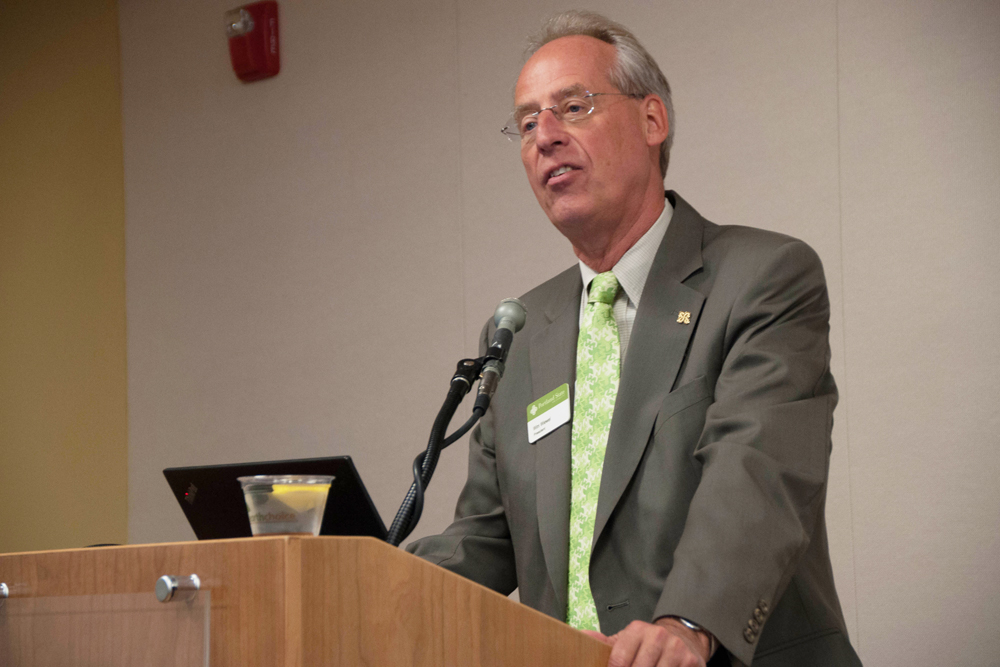Overworked, underpaid
With an ever-increasing workload, lower than average salary, and swelling classroom sizes, Portland State faculty say there may be a crisis at PSU in academic quality if the Oregon University System (OUS) does not receive increased funding.
PSU geology Professor Scott Burns said that Portland State has lost many faculty members, mostly young ones, to higher paying, less labor-intensive positions around the country. He said that a drop in higher education funding, paired with increased enrollment, has led to changes in the climate on campus.
An OUS progress report from October showed increases in enrollment and research funds in Oregon universities and said fundraising efforts are bringing in more money than ever before, but Burns said that the figures of the report are misleading.
”[The report] gives a rosy picture for higher education,” said Burns, who is also the inter-institutional faculty senate president. “Academic quality is not reflected in the numbers.”
Oregon’s public universities are ranked 46th in the nation for per student funding, down from 25th in 1990. Burns said the higher than average student to faculty ratio – about 29 students per faculty member, according to OUS – and a lack of adequate secretarial support have forced faculty members to work exorbitant hours for a salary lower than the national average. Portland State faculty members are paid 84 percent of the average national salary for university teachers, according to OUS.
”Everybody you talk to will agree we are all pooped,” Burns said.
Burns, currently in his 37th year teaching and 17th year at PSU, said he has seen the decrease in Oregon’s enthusiasm for its higher education program first hand. The OUS budget for the 2005-07 biennium was $732.4 million, about 6 percent of the entire state general fund. For the 1971-73 biennium, OUS received 22.5 percent, $179 million, of the state general fund.
Burns said that faculty morale is currently not as low as it has been in the past due mostly to the dedication faculty has to the university and students. But the high faculty turnover is contributing to what Burns said he sees as the death of a faculty community.
Monday was the last meeting of the 50-year-old Ferdinand Society, an elite faculty association at PSU, of which Burns was the president. Burns said that the busy careers of faculty led to diminishing membership for the club.
Budget proposal may bring answers
Burns said there is hope, though. The budget request for the 2007-09 OUS biennium increased over the current biennium by $190.2 million, up to $922.6 million for the seven Oregon public universities. The budget is still waiting for approval from the governor’s office and the state Legislature still must approve the drastic budget request increase when the Legislature meets in January.
Di Saunders, OUS director of communications, said that $29 million in the proposed 2007-09 biennium budget is set aside for faculty salary increases. If the budget is approved, OUS will also add $17 million specified to help reduce student-faculty ratios and $16 million to help meet projected enrollment growth.
A $30 million faculty salary increase was slated for the 2005-2007 OUS budget, but was lowered to $1 million because of the state of Oregon’s economy at the time, Saunders said. This year, she said, the economy has improved so OUS hopes the increase will be approved.
OUS has set aside time from February through April to review faculty issues and concerns, Saunders said, to help ease faculty trepidation about their jobs.
”What we try to do is talk about what faculty offers to the university system,” Saunders said. “We have faculty really tell their stories through their voices. I think there’s a recognition by everyone that the strength of our universities relies on the strength of our faculty.”
Burns said these additional funds are a step in the right direction and could bring PSU more faculty, increase salaries, and fund deferred maintenance for many of PSU’s old buildings.
Survey clues PSU into faculty morale issues
The university is working to solve the faculty morale issues, according to Kathi Ketcheson, director of Institutional Research and Planning and presiding officer of PSU’s faculty senate.
A faculty survey was completed this fall to let faculty members voice concerns. The issues most talked about, according to Ketcheson, were inadequate compensation and the ever-increasing faculty workload.
Ketcheson said the university is examining the survey’s results and is working on a planning process to deal with faculty concerns, but she said it would take more state support to make any progress.
Ketcheson is cautious about believing that state support will come, however. She said she has heard the university system talk about fixing its problems many times during her tenure at PSU, but state support has continually diminished, which makes her wary that anything will get done.
”It calls for a different model, or some drastic change,” Ketcheson said. “The state has to make a commitment.”
Burns said an inordinate amount of short term, or adjunct faculty, is another significant cause of the diminishing faculty morale. About two-thirds of faculty in the Portland State chapter of the American Association of University Professors, the faculty union, are on year-to-year contracts, as opposed to tenure track. Some of the fixed-term faculty members have been at the university for over 20 years, according to Portland State AAUP Executive Director Julia Getchell.
Adjunct faculty are rarely invited to participate in faculty meetings, and in many cases do not have office space, making it difficult to meet with students and adequately perform their duties, Getchell said.
”The university tries to save money by hiring people on short-term contracts,” Getchell said. “The working conditions are difficult to meet with students, or engage in a scholarly agenda.”
Faculty union preparing for more salary negotiations
Getchell said the concern AAUP has is that the extra work instructors are picking up – from emptying their own trash cans to working extra hours on the weekend – affects academic quality to a point that negatively affects PSU students’ learning experience. She said faculty must make academic sacrifices to save time, such as giving multiple-choice tests that are easier to grade, instead of more educationally enriching essay questions.
”I’ve talked with faculty. The increasing number of students in classrooms and increasing number of courses taught changes how they teach,” Getchell said. “You can’t be assigning five-page papers every week, even though these faculty would rather do more in-depth critical-thinking exercises.”
After nearly three years without a salary increase and extensive contract negotiations, faculty at PSU were awarded an incremental 8 percent salary increase, to be paid out in three parts: 5 percent last winter, 2 percent at the beginning of this year and another 1 percent this upcoming winter term.
AAUP is preparing for another set of salary negotiations next year. Getchell said the OUS 2007-2009 legislative agenda includes some language that will hopefully get PSU faculty salaries, which are about 84 percent of the national average, up to the average within 10 years.
”In spite of the low pay and the increasing workload, the thing that keeps faculty here is the students,” Getchell said. “It’s a miracle that people show up to work every day.”





